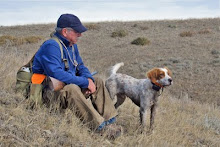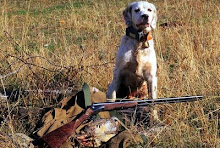
Once there were more than 2 million sage grouse throughout the West. Now, the best estimate is that there are somewhere between 200,000 and 300,000 of the birds left in the United States, mostly in Wyoming, Colorado, Montana and Idaho. For those of us who run bird dogs in these areas, the decline is evident. Populations have been declining for years.
The greater sage grouse was reviewed for ESA listing previously (2004) but the panel responsible, after reviewing the presented scientific evidence chose not to list the bird. In 2007 however, a federal district court concluded that the Fish and Wildlife Service’s (FWS) finding that the listing of the greater sage grouse as “not warranted” was arbitrary and capricious. The court reasoned that FWS ignored the best available science, excluded experts from the listing decision, and failed to logically evaluate the current circumstance of the sage grouse. Furthermore, the court found that FWS invalidated the listing decision partially due to the “inexcusable conduct” of political appointee Julie MacDonald, who tainted the process by editing scientific conclusions.[citation here].
According to the USFWS, “Once listed, a species is afforded the full range of protection available under the ESA including prohibitions on killing, harming or otherwise taking a species. In some instances, species listing can be avoided by development of a Candidate Conservation Agreement that may work to remove potential threats facing the candidate species.”
In states like Wyoming oil and gas production, wind farm energy production, coal mining, and possibly ranching could be heavily impacted. Western states would likely lose valuable jobs and significant tax revenue if the sage grouse is protected throughout its range. An endangered listing would be "absolutely devastating" by requiring sage grouse to be considered ahead of virtually any development in most of the state, said Ryan Lance, deputy chief of staff to Wyoming Governor Dave Freudenthal.

On the other hand, sage grouse have been declining steadily over most of their range due to habitat destruction, disruption by development activity, and possibly grazing. Add to this the impact that West Nile Virus has had over the past couple of years, and there are many people concerned that, if nothing is done, the sage grouse will be extirpated across most of its range.
The plight of the sage grouse and, apparently, the threat of listing the bird for ESA protection has galvanized all parties concerned – extractive industries, state governments, environmental groups, and public land managers.
The extractive industries are working to prevent listing by sponsoring studies, programs to assist local management, and, I expect, by lobbying anyone who will listen. Western states are making some effort to field sage grouse 'management programs' which might prevent the USFWS from taking them out of the sage grouse management picture by ESA listing the sage grouse. Environmental groups are fighting to have the native grouse listed, which would severely limit habitat encroachment.
Strangely, there seems to be little active interest among upland bird hunters, even though this would be the first game bird to be listed under the ESA.
There seems to be little common ground here - perhaps it is too late to find common ground. It is too bad that we lack the foresight and citizenship to work to prevent crisis management in which everyone may lose, especially the the very object we are trying to protect... the greater sage grouse.
According to the USFWS, “Once listed, a species is afforded the full range of protection available under the ESA including prohibitions on killing, harming or otherwise taking a species. In some instances, species listing can be avoided by development of a Candidate Conservation Agreement that may work to remove potential threats facing the candidate species.”
In states like Wyoming oil and gas production, wind farm energy production, coal mining, and possibly ranching could be heavily impacted. Western states would likely lose valuable jobs and significant tax revenue if the sage grouse is protected throughout its range. An endangered listing would be "absolutely devastating" by requiring sage grouse to be considered ahead of virtually any development in most of the state, said Ryan Lance, deputy chief of staff to Wyoming Governor Dave Freudenthal.

This photo shows the impact of oil and gas extraction, which has blossomed on lands that were once sage grouse habitat. The fragmentation and activity have effectively destroyed greater sage grouse habitat in large areas of several Western states
On the other hand, sage grouse have been declining steadily over most of their range due to habitat destruction, disruption by development activity, and possibly grazing. Add to this the impact that West Nile Virus has had over the past couple of years, and there are many people concerned that, if nothing is done, the sage grouse will be extirpated across most of its range.
The plight of the sage grouse and, apparently, the threat of listing the bird for ESA protection has galvanized all parties concerned – extractive industries, state governments, environmental groups, and public land managers.
The extractive industries are working to prevent listing by sponsoring studies, programs to assist local management, and, I expect, by lobbying anyone who will listen. Western states are making some effort to field sage grouse 'management programs' which might prevent the USFWS from taking them out of the sage grouse management picture by ESA listing the sage grouse. Environmental groups are fighting to have the native grouse listed, which would severely limit habitat encroachment.
Strangely, there seems to be little active interest among upland bird hunters, even though this would be the first game bird to be listed under the ESA.
There seems to be little common ground here - perhaps it is too late to find common ground. It is too bad that we lack the foresight and citizenship to work to prevent crisis management in which everyone may lose, especially the the very object we are trying to protect... the greater sage grouse.









4 comments:
Mike,
Good and timely post. I agree with you on the lack of common ground. The photo you post shows how "just a few acres" of development can compromise the hundreds of acres between by cutting it to ribbons. The country needs energy, open areas of the west need jobs, nobody but a few birds and animals like sage, apart from a few hunters and environmentalists and one way or the other the devil may take the hindmost.
I think you don't hear much because so few people hunt sage grouse. They have a bad reputation (unwarranted) as table fare, have low bag limits (one or even a special tag and lottery in California), and are in the Way Out West.
In an odd way, I'd like to bag just one more to eat a ceremonial farewell meal before they list them.
Oh, and as for a game bird listed, wasn't the prairie chicken listed as threatened?
Hank, I think sage grouse, if they remain unlisted deserve 'trophy' status. I see them fairly frequently while hiking and hunting, but have not shot one in maybe 20 years.
I think you should give it a go during the limited California season. I would check the sage reas around rivers in the Bishop/Mono Lake areas, or go north of Susanville into Lassen and Modoc counties.
It is quite an experience to see these large elegant birds.
Hank - further to your question, you are right - Atwater's Prairie chicken has been ESA listed since 1967. Only a few hundred birds exist on a couple of hundred thousand acres of coastal grasslands in Eastern Texas.
The lesser prairie chicken has been considered for listing, I believe, but is not currently listed AFAIK.
Post a Comment